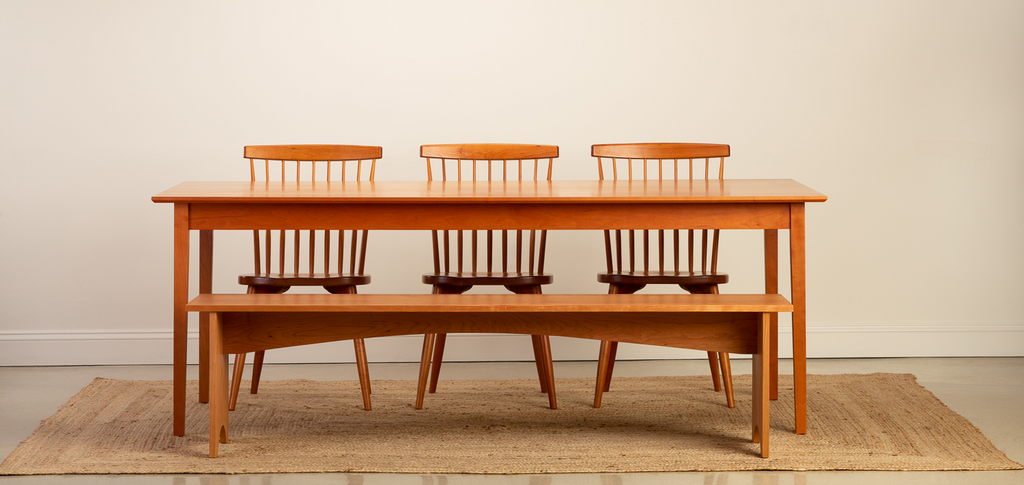Does form follow function, or function follow form? It’s an age-old debate in design, one that questions which is more important—that a piece performs well or that it simply looks beautiful?
For the Shakers, there was no debate. Form firmly followed function. But what soon became apparent was that, with the Shakers, form following function led to a simple, timeless aesthetic. Today, you’ll find Shaker style furniture incorporated in home decorating aesthetics ranging from country farmhouse to modern minimalist.
What is it about Shaker furniture that we love? Let’s take a look at some of the characteristics that make Shaker furniture so appealing.
About the Shakers
To understand the characteristics of Shaker furniture, you first have to understand who the Shakers were—because it was from the depth of their beliefs that their aesthetic arose.
Founded by an English factory worker named Ann Lee, Shakerism came to America in 1774, when Lee arrived with 8 other pilgrims. At its height, Shakerism boasted over 6000 adherents living in 19 communal villages spread from New England to Ohio and Kentrucky. Today, there is only one remaining active Shaker community, located in New Gloucester, Maine.
With celibacy an important part of the belief system, Shakers converted to the faith; none were born to it. Men and women left their biological families to join Shaker communities, where they lived together as brothers and sisters. All property was communal, and each Shaker worked hard to transform earth into heaven.
The belief that it was the duty of the believer to live purely and to seek perfection in everything he or she did, guided Shaker furniture makers as they practiced their craft.
Shaker furniture characteristics
For Shakers, God was in the detail and quality of work, so they gave their all to their craftsmanship. Believing that excessive ornament led to the sin of pride, Shaker furniture makers concentrated on the overall form and proportions of their pieces. While the pieces look simple, they are built with a high standard of quality and show extraordinary attention to detail and overall proportions.
Practical, innovative design
Shaker furniture is famous for its ingenuity and practicality. In contrast to the Amish, who are known to shun new technology, Shakers experimented with labor-saving devices and made much of their furniture with circular saws, mortising machines, and steam-powered lathes.
Natural, local materials
Shaker practicality began with choice of materials, with furniture makers choosing readily available materials over expensive imports. Woods such as oak, maple, pine, cherry, walnut, poplar, and hickory were found nearby and used to make beds, chests of drawers, chairs, tables, even the knobs used for opening drawers and cabinetry.
Ladderback
While the ladderback chair has existed since the Middle Ages, it was the Shakers who turned it into an art form through innovation and creativity.
Ladderback chairs have backrests made from wooden slats that run horizontally between the chairs' posts. Those same wooden slats could be used to hang the chairs on peg boards. Hanging the chairs served two purposes. First, it got the chairs up and off the floor, making clean-up easy. Second, additional seating could be kept nearby and readily available without taking up floor space.
In order to facilitate hanging, Shakers made the chairs as lightweight as possible. They did this by tapering and turning the chair legs. Tapering is the gradual thinning in thickness of the legs as they get closer to the floor. Turning creates a cylindrical leg with the use of a lathe. Tapered and turned chair legs are two characteristics of Shaker furniture.
While early designs used woven cane, rush or splint for seats, the Shakers wove together cotton twill tapes for seats. They were not only comfortable but more durable and easier to install than cane, rush, or splint.
The Shakers also added a ball and socket mechanism to the back two legs, which allowed the chair to tilt back without slipping and provided a more comfortable seating experience. These chairs became known as the Shaker tilting chair.
Graduated drawers
Graduated drawers are another characteristic of Shaker furniture. The Shakers built bureaus and chests with the largest drawers located at the bottom of the piece and each successive drawer becoming smaller towards the top. Larger bottom drawers are perfect for blankets and clothes, while smaller top drawers are better for socks and other undergarments. Plus placing larger, heavier items at the base of the piece, makes it more stable and less likely to overturn. Practicality at its best.
Attention to detail
If, as they believed, God was in the details, attention to detail was paramount. The Shakers used dovetail joinery, which is beautiful and strong. Dovetail joinery uses one or more tapered projections on one piece that interlock with notches in the piece to be joined, and vice versa. These can often be seen on drawer boxes. The Shakers also used mortise and tenon joints, which consist of a projection, typically on the end grain of wood, that is glued into a recess typically on the side grain of wood. The use of these traditional woodworking techniques meant that their furniture was built to last.
Choosing Shaker Style furniture today
Shaker furniture is widely considered a timeless design. Today, close to a quarter of a millenia later, people still seek the Shaker aesthetic for their homes. Whether the overall decor style is modern, minimalist, or traditional, Shaker style furniture has a place with those who appreciate the practical, understated, and uncompromising attention to detail of the Shaker look.
Do you appreciate the characteristics of Shaker furniture? See Chilton Furniture’s collections of Shaker style handcrafted furniture.



1 comment
Appreciate the explanation of Shaker furniture design and construction… but no mention of the soft, subtle colors used on doors etc. seems like a juxtaposition from the very conservative Shaker philosophy and “life style”… I’m fortunate to own several cherry Shaker bedside tables, estimated to be over 200 years old.
Leave a comment